
In today’s world, the issue of commercial food waste has become a pressing concern, both from an environmental and economic standpoint.
As businesses across the UK grapple with the challenge of reducing their environmental footprint and operating sustainably, managing food waste has emerged as a critical area for improvement.
In this comprehensive guide, we will delve into everything you need to know about food waste in business settings, including its impact, regulations, management strategies, and disposal methods.
Table of Contents
- What is Food Waste?
- Impact of Food Waste
- Food Waste Laws and Regulations
- How to Manage Food Waste in Your Business
- Food Waste Disposal Methods
- Food Waste Facts & Statistics
- Conclusion

What is Food Waste?
Food waste is any food that is purposely thrown away or is lost along the supply chain, from production and processing, to distribution and consumption.
Business food waste occurs in various stages, including overproduction, spoilage, and customer leftovers.
According to the Waste and Resources Action Programme (WRAP), the UK generates an estimated 9.5 million tonnes of food waste annually, with businesses accounting for a significant portion of this total.
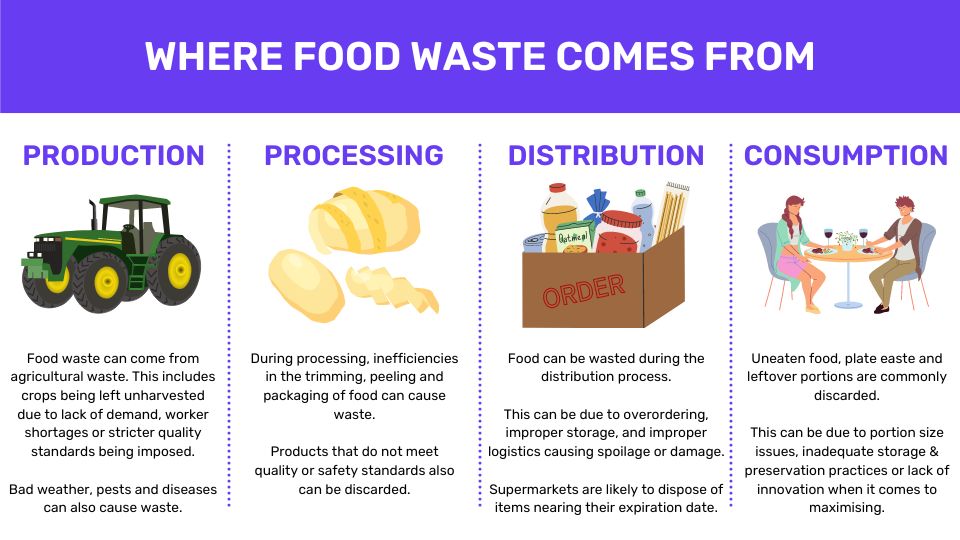
Where Does Business Food Waste Come From?
Business food waste can come all the way from production & harvesting, to processing & manufacturing, distribution & retail and consumption.
Production & Harvesting
Food waste often begins at the agricultural stage, where crops may be left unharvested due to market fluctuations, labour shortages, or strict quality standards imposed by retailers.
Additionally, adverse weather conditions, pests, and diseases can result in significant losses during cultivation.
Processing & Manufacturing
During food processing and manufacturing, inefficiencies in production processes, such as trimming, peeling, and packaging, can lead to the generation of waste.
Additionally, products that do not meet quality or safety standards may be discarded or downgraded for alternative uses.
Distribution & Retail
Food waste continues to accumulate during distribution and retail operations, where factors such as overordering, improper storage, and inefficient logistics contribute to spoilage and shrinkage.
Supermarkets and grocery stores often discard perishable items nearing their expiration dates to maintain freshness and uphold aesthetic standards.
Consumption
While households are significant contributors to food waste, businesses, including restaurants, hotels, bakeries, butchers, nurseries, and catering services, also play a crucial role.
Read more about our tips and tricks for bakeries to get to zero-waste!
Uneaten food, plate waste, and leftover portions are commonly discarded, either due to portion sizes exceeding consumer appetite or inadequate storage and preservation practices.
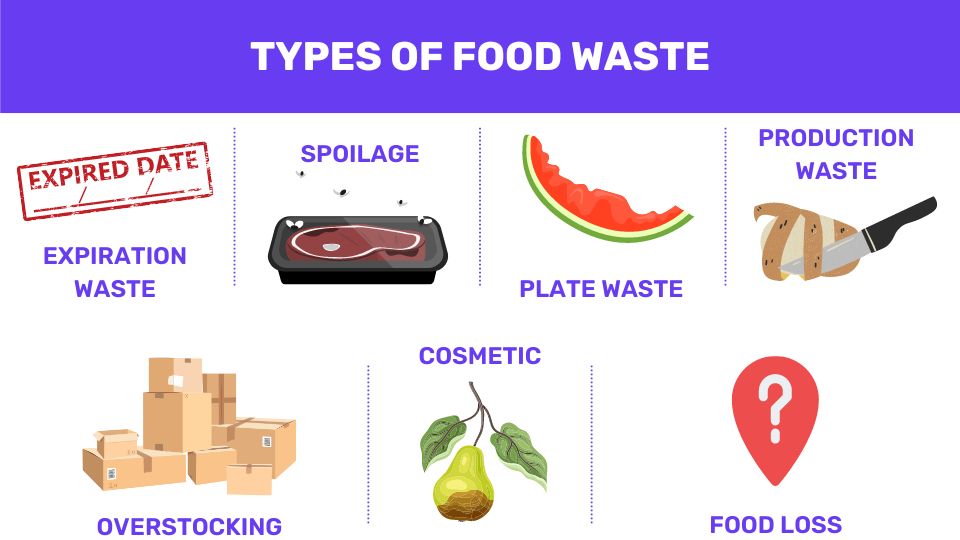
What Are The Types of Food Waste?
There are 7 types of food waste, including expiration, spoilage, plate waste, production waste, overstocking/overordering, cosmetic imperfections, and food loss.
Expiration Waste
This type of food waste occurs when products reach their expiration dates or “best before” dates and are discarded as unsuitable for consumption.
Expiration dates are often conservative estimates, leading to premature disposal of perfectly edible food items.
Spoilage
Spoilage waste occurs when food deteriorates in quality or becomes unfit for consumption due to factors such as exposure to air, moisture, temperature fluctuations, or microbial contamination.
Some people may refer to this food as “gone off”.
Perishable items such as fruits, vegetables, dairy products, and meats are particularly susceptible to spoilage if not stored properly.
Plate Waste
Plate waste refers to the uneaten portions of food left on plates or trays after meals, commonly observed in restaurants, cafes, and catering services.
Plate waste may also be called leftovers or table scraps.
Factors contributing to plate waste include oversized portions, limited consumer appetite, and food preferences or dislikes.
Production Waste
Production waste occurs during the manufacturing and processing of food products, where by-products, trimmings, and imperfect items are discarded as part of the production process.
This type of waste includes peels, cores, skins, and other edible or inedible parts separated during food preparation.
Overstocking/ Overordering
Businesses often overstock or overorder food items to meet fluctuating demand or take advantage of bulk purchasing discounts.
However, excess inventory can lead to waste if products perish or expire before they can be sold or consumed.
Cosmetic Imperfections
Cosmetic imperfections, such as misshapen fruits and vegetables or blemished surfaces, often result in the rejection of otherwise edible produce by retailers and consumers.
Despite being perfectly safe and nutritious, aesthetically imperfect items are frequently discarded due to consumer preferences for visually appealing products.
Logistical Losses
Logistical losses occur during transportation, storage, and distribution processes, where food may be damaged, mishandled, or lost due to accidents, equipment failures, or inefficiencies in supply chain operations.
By identifying and categorising the various types of food waste, businesses can implement targeted interventions and best practices to minimise waste generation, optimise resource utilisation, and promote sustainability throughout the food supply chain.
Strategies such as inventory management, portion control, food donation programs, and waste diversion initiatives can help mitigate the impacts of food waste and create a more efficient and resilient food system.
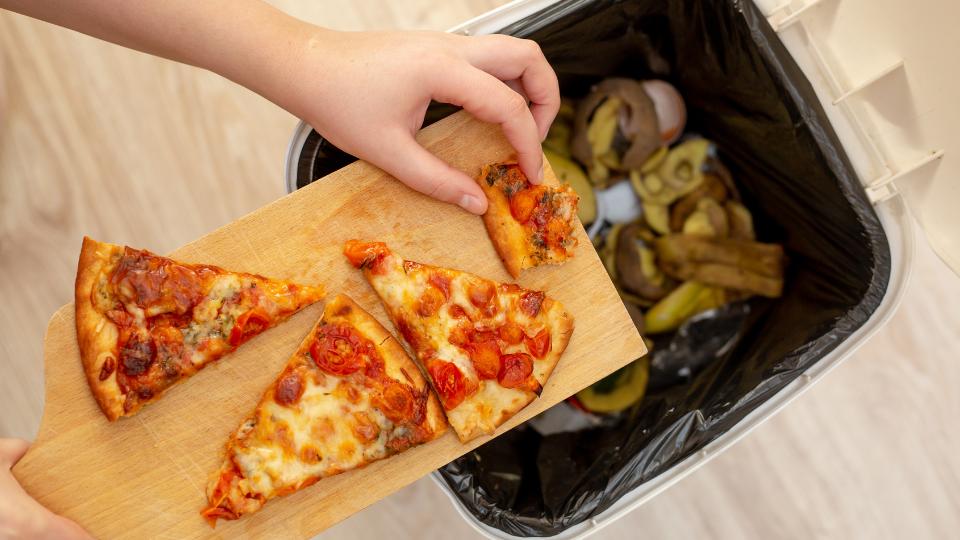
Impact of Food Waste
The consequences of food waste extend beyond the realm of environmental sustainability, impacting social, economic, and ethical dimensions.
Environmental Impact
Food waste has significant environmental implications, primarily due to its contribution to greenhouse gas emissions and depletion of natural resources.
Greenhouse Gas Emissions
When food waste is sent to landfills, it undergoes anaerobic decomposition, releasing methane gas into the atmosphere.
Methane is a potent greenhouse gas with a much higher global warming potential than carbon dioxide.
By contributing to methane emissions, food waste exacerbates climate change and its associated environmental impacts.
Resource Depletion
The production of food requires significant resources, including water, land, energy, and inputs such as fertilisers and pesticides.
When food is wasted, these resources are essentially squandered.
For example, water used in irrigation and food processing is wasted when food is discarded, contributing to water scarcity and inefficiency in resource utilisation.
Additionally, arable land that could be used for food production is lost, further exacerbating pressures on natural ecosystems and biodiversity.
Social Implications
The social consequences of food waste are profound, affecting vulnerable populations and perpetuating inequalities
Food Insecurity
While millions of people around the world suffer from hunger and malnutrition, vast quantities of edible food are needlessly discarded.
Food waste exacerbates food insecurity by diverting resources away from those who need it most.
Surplus food that could alleviate hunger is often thrown away, highlighting the paradoxical nature of food waste in the face of global hunger.
Social Disparities
Inequities in food distribution and access further compound the social impacts of food waste.
Vulnerable populations, including low-income households, marginalised communities, and food-insecure individuals, bear the brunt of food waste’s consequences.
Lack of access to affordable, nutritious food perpetuates cycles of poverty and exacerbates social disparities, creating barriers to food security and well-being.
Economic Costs
Food waste imposes significant financial burdens on businesses and society as a whole, undermining profitability and economic sustainability
Wasted Resources
Businesses incur substantial financial losses due to wasted resources throughout the food supply chain.
This includes raw materials, energy, water, and labour invested in the production, processing, transportation, and storage of food.
When food is discarded, these resources are essentially wasted, diminishing the return on investment and contributing to inefficiencies in resource allocation.
Missed Revenue Opportunities
In addition to direct costs associated with wasted resources, businesses also miss out on potential revenue opportunities when food is discarded rather than sold or consumed.
Overproduction, spoilage, and unsold inventory result in lost sales and forgone profits, further exacerbating financial losses and reducing overall profitability.
Disposal Expenses
Managing food waste incurs additional expenses related to its collection, transportation, and disposal.
Businesses must bear the cost of waste management services, landfill fees, and compliance with regulatory requirements governing food waste disposal.
Moreover, inefficient waste management practices can result in reputational damage and legal liabilities, further compounding the economic costs of food waste.
In summary, addressing the environmental, social, and economic impacts of food waste requires concerted efforts across all sectors of society.
By implementing strategies to prevent waste generation, redistribute surplus food, and promote sustainable consumption practices, businesses and communities can mitigate the adverse effects of food waste and build a more resilient and equitable food system.

Food Waste Laws and Regulations
In addition to the Waste (England and Wales) Regulations 2011 and the Waste (Scotland) Regulations 2012, there are several other relevant legislations and regulations in the UK aimed at addressing food waste management and promoting sustainability:
The Environmental Protection Act 1990
The Environmental Protection Act 1990 provides a framework for waste management in England and Wales, including provisions for controlling the disposal and treatment of waste, licensing of waste management facilities, and enforcement of waste regulations.
The Waste (England and Wales) Regulations 2011
The Waste Regulations 2011 are derived from the Environmental Protection Act 1990, set out specific requirements for waste management, including obligations for businesses to segregate, store, transport, and dispose of their waste safely and responsibly.
The regulations also promote waste prevention, reuse, recycling, and recovery practices to minimize the environmental impact of waste generation.
The Waste (Scotland) Regulations 2012
Similar to its counterpart in England and Wales, the Waste Regulations 2012 for Scotland establish legal requirements for waste management in Scotland, encompassing waste prevention, recycling, and disposal measures.
Businesses are obligated to comply with waste management principles and implement measures to minimise the environmental impact of their waste activities.
The Environment Act 2021
The Environment Act 2021 sets out defined regulations that mandate certain businesses, including food retailers, hospitality establishments, and food service providers, to separate food waste from other waste streams for collection and recycling purposes.
The aim is to divert organic waste from landfills and promote the sustainable management of food waste through composting, anaerobic digestion, or other environmentally friendly methods.
The Waste (Miscellaneous Amendments) (EU Exit) (No. 2) Regulations 2019
This legislation makes technical amendments to existing waste regulations in preparation for the UK’s exit from the European Union.
It ensures continuity and clarity in waste management practices while aligning with domestic priorities and regulatory frameworks.
The Circular Economy Package
While not specific to food waste, the UK government has committed to implementing measures outlined in the Circular Economy Package to promote resource efficiency, waste reduction, and sustainable consumption and production practices.
The package includes initiatives to incentivise waste prevention, improve recycling infrastructure, and support the transition to a circular economy model.
Compliance with these legislations and regulations is essential for businesses to avoid penalties, uphold environmental standards, and contribute to the collective effort to reduce food waste and promote sustainability in the UK.
Moreover, businesses are encouraged to adopt proactive measures, such as waste audits, staff training, and collaboration with waste management providers, to achieve efficient and responsible management of food waste in line with regulatory requirements.
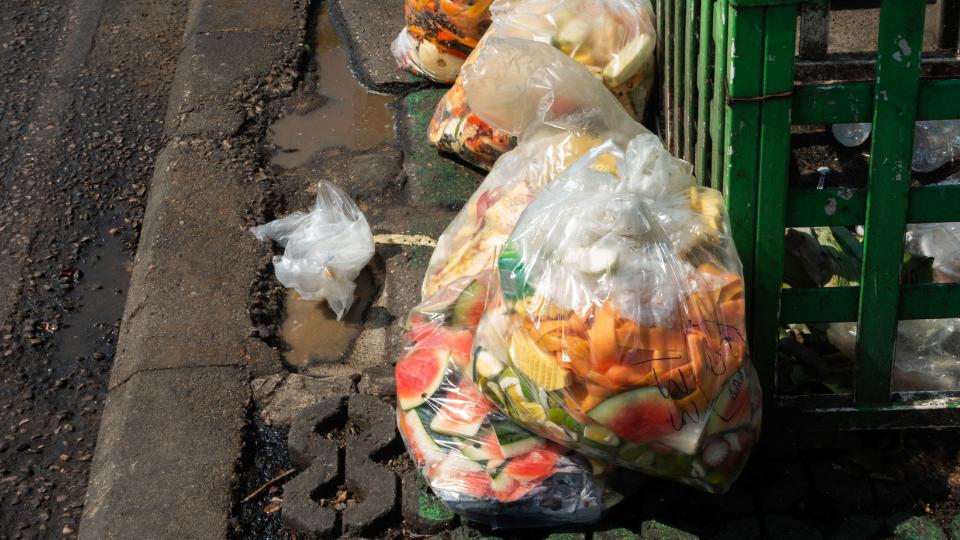
How to Manage Food Waste in Your Business
Effective management of food waste is essential for businesses to minimise their environmental impact, reduce costs, and enhance sustainability.
Conduct a Waste Audit
Conducting a waste audit will involve systematically assessing and analysing the types and quantities of the food waste that’s generated by your business.
Identify the areas of waste generation, such as food preparation, storage, and disposal, as well as potential causes and opportunities for improvement.
Analyse the data from waste audits to set measurable targets, track progress, and inform decision-making in implementing waste reduction initiatives.
Optimise Inventory Management
Implementing efficient inventory management practices, such as just-in-time (JIT) ordering and inventory tracking systems, can help minimise overstocking and reduce food waste.
Use forecasting tools and demand planning techniques to anticipate customer demand, optimise stock levels, and prevent excess inventory accumulation.
Rotate perishable items based on first-in-first-out (FIFO) principles to minimise spoilage and ensure product freshness.
Educate Staff
Providing comprehensive training and education to employees on proper food handling techniques, portion control, and waste segregation practices is crucial.
Train staff to identify signs of spoilage, adhere to food safety protocols and implement portioning guidelines to minimize plate waste and optimise portion sizes.
Foster a culture of waste reduction and sustainability among employees by raising awareness of the environmental and economic impacts of food waste and empowering them to take proactive measures.
Donate Surplus Food
Establish partnerships with local charities, food banks, or community organizations to donate surplus food that is still safe for consumption but unsuitable for sale or use.
Coordinate with food rescue organizations to arrange for timely collection and distribution of surplus food to individuals and families in need.
Ensure compliance with food safety regulations and guidelines when handling and donating surplus food to maintain quality and prevent foodborne illnesses.
Implement Food Waste Reduction Technologies
Explore innovative technologies and solutions for managing food waste, such as composting, anaerobic digestion, or food waste-to-energy systems.
Composting organic waste can divert food scraps from landfills and produce nutrient-rich compost for soil enrichment and agricultural purposes.
Anaerobic digestion facilities can convert organic waste into biogas and nutrient-rich digestate through microbial decomposition, offering renewable energy and organic fertilizer alternatives.
Investigate the feasibility of investing in food waste-to-energy systems, such as biofuel production or thermal conversion technologies, to generate renewable energy from organic waste streams while reducing greenhouse gas emissions.
By implementing these practical steps and strategies, businesses can proactively address food waste challenges, optimize resource utilization, and contribute to a more sustainable and resilient food system. Moreover, embracing a holistic approach to food waste management can enhance brand reputation, foster stakeholder engagement, and create value for both businesses and communities.
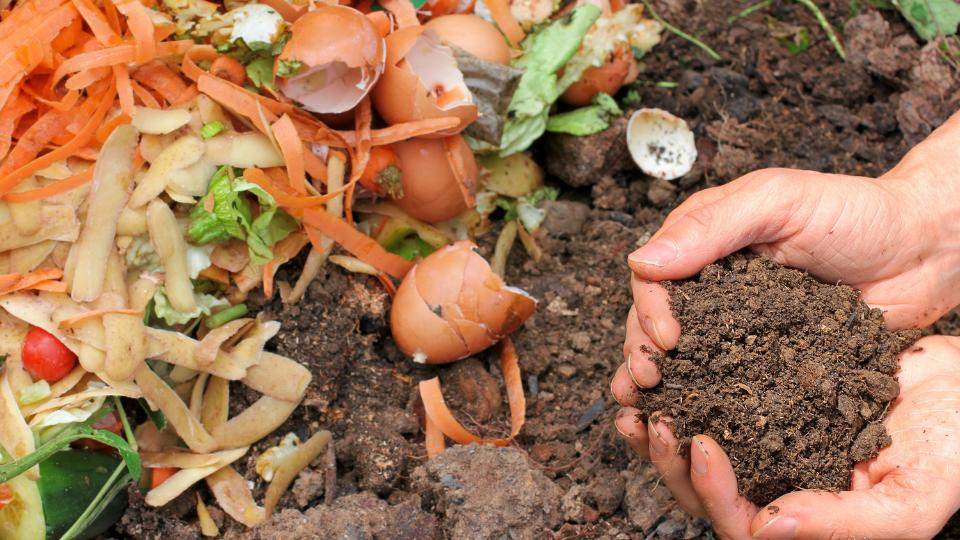
Food Waste Disposal Methods
When it comes to disposing of food waste, businesses have a range of options available to them, each with its own benefits and considerations.
By carefully considering these options and choosing the most suitable approach, businesses can effectively manage their food waste while minimising their environmental impact and maximising resource efficiency.
Here are some of the key disposal methods for food waste:
Anaerobic Digestion
Anaerobic digestion is a biological process in which organic waste, including food scraps, is broken down by microorganisms in the absence of oxygen.
During anaerobic digestion, microorganisms convert organic matter into biogas, primarily methane and carbon dioxide, which can be captured and used as a renewable energy source.
Additionally, the remaining solid residue, known as digestate, is nutrient-rich and can be used as a soil conditioner or fertiliser to enhance soil health and promote plant growth.
Anaerobic digestion facilities offer a sustainable solution for managing organic waste while simultaneously generating renewable energy and reducing greenhouse gas emissions.
Composting
Composting is a natural process in which food scraps and other organic matter are decomposed by microorganisms, fungi, and earthworms into nutrient-rich compost.
Food waste, along with yard trimmings, leaves, and other organic materials, is collected and placed in composting bins or piles, where it undergoes biological decomposition.
Over time, the organic matter breaks down into humus, a dark, crumbly substance rich in nutrients, which can be used to enrich soil, improve soil structure, and enhance plant growth.
Composting offers an environmentally friendly way to recycle food waste, diverting it from landfills and reducing methane emissions while producing a valuable soil amendment.
Food Waste-to-Energy
Food waste-to-energy technologies convert organic waste into renewable energy, such as biogas or biofuels, through thermal or biochemical conversion processes.
Thermal conversion technologies, such as incineration or pyrolysis, heat organic waste to high temperatures in the absence of oxygen, producing combustible gases or liquids that can be used to generate electricity or heat.
Biochemical conversion technologies, such as fermentation or enzymatic digestion, break down organic waste into simpler molecules, which can be converted into biogas, bioethanol, or biodiesel through microbial or enzymatic processes.
Food waste-to-energy facilities offer an alternative to landfill disposal, providing a sustainable source of renewable energy while reducing greenhouse gas emissions and dependence on fossil fuels.
Landfill
Landfill disposal is a traditional method for managing food waste that cannot be recycled, recovered, or processed through alternative means.
Food waste disposed of in landfills undergoes anaerobic decomposition, producing methane, a potent greenhouse gas, as a byproduct.
While landfill disposal is convenient and cost-effective, it poses significant environmental risks, including groundwater contamination, soil degradation, and air pollution.
To mitigate the environmental impacts of landfilling food waste, it is essential to prioritize waste reduction, recycling, and diversion to more sustainable disposal methods.
Food Waste Bins
In addition to implementing advanced food waste management technologies, businesses can take practical steps to facilitate waste separation and collection through the use of dedicated food waste bins.
These bins are specifically designed to capture and contain organic waste, making it easier for businesses to segregate food scraps from other waste streams.
Food waste bins come in various sizes and configurations to accommodate different volumes of waste and can be placed strategically throughout commercial kitchens, dining areas, and food preparation areas.
By incorporating food waste bins into their waste management infrastructure, businesses can promote waste separation, facilitate composting or anaerobic digestion, and minimise contamination of recyclable materials.
Moreover, providing convenient and accessible food waste bins encourages employees to participate in waste reduction efforts and reinforces the organisation’s commitment to sustainability and environmental stewardship.
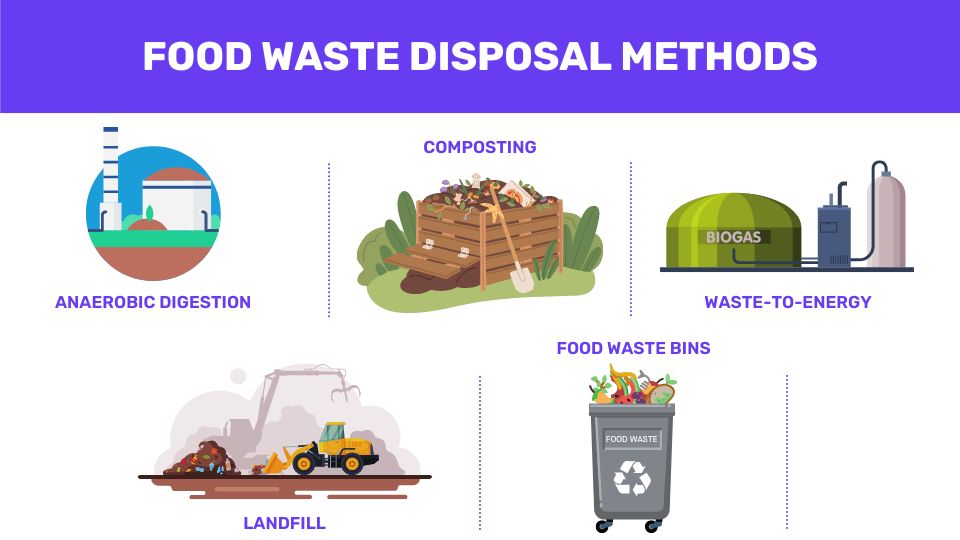
Food Waste Facts & Statistics
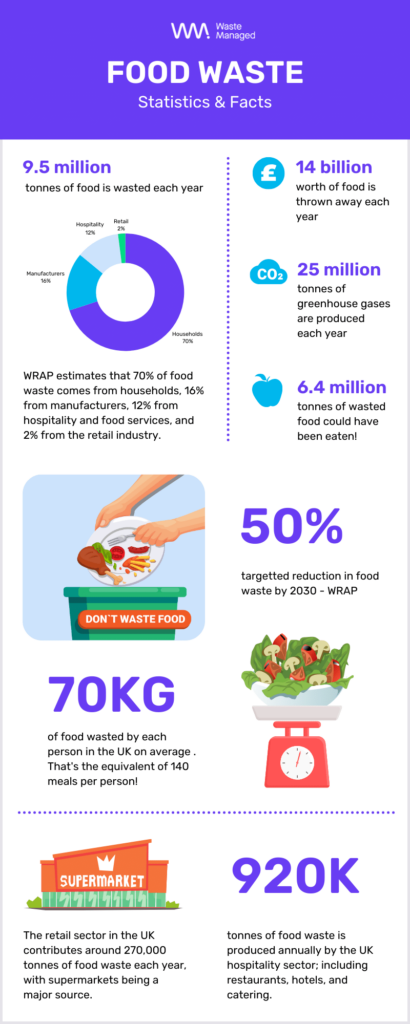
- Nearly one third of all food produced is wasted before it can be eaten
- Food waste squanders nearly a quarter of the world’s fresh water supply.
- The water that’s wasted by misspent food could be used by 9 billion people, giving each person 200 litres per day.
- Europe wastes between 95-115 kg of food per year per person!
- If food waste was a country, it would be the third-largest greenhouse gas emitter behind China and the United States.
- Half of all produce is thrown away because it is deemed not attractive enough for the consumer.
- The land that is used to grow food that never actually gets eaten is larger than China!
- 63% of people don’t know the difference between “use by” and “best before” dates displayed on food packaging, which results in more unnecessary disposal of perfectly edible food.
- 40-60% of fish that are caught in Europe are just thrown away due to being the incorrect size for retailer guidelines or not of a high enough quality.
Read our full facts guide for more food waste statistics!

Conclusion
In conclusion, it is paramount for UK businesses to recognise that managing food waste is not just a moral obligation but also a critical aspect of sustainable business practices.
By embracing proactive measures to address food waste at every stage of the supply chain, businesses can simultaneously mitigate their environmental impact, comply with regulatory requirements, and unlock significant cost savings.
However, beyond the immediate benefits to the bottom line, effective food waste management also contributes to building a more resilient and equitable food system for present and future generations.





